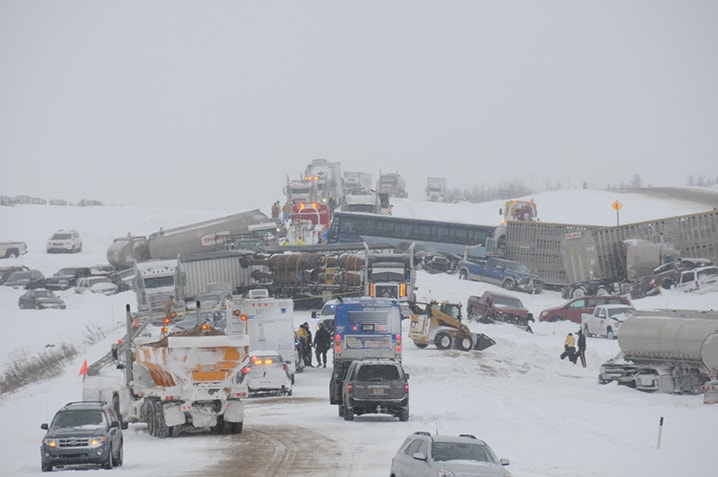Determining the cause of an accident is not always as clear as night and day.
Often there’s conflicting witness statements or little evidence.
But it’s up to Red Deer RCMP Cpl. James Laronde and his partner Cpl. Donavan Gulak to discover what happened.
Laronde, a 25 year-police veteran, is one of a two-person unit that does forensic collision reconstruction in the area between Wetaskiwin and Didsbury. There are only 10 full-time reconstructionists in all of Alberta.
They use tools like a miniature unmanned helicopter that carries a digital camera to take aerial photos and survey equipment to take scene measurements. The specialized police officer imports the data into a computer drafting program.
The information will piece together the crash by producing drawings or animations. In most cases, Laronde will be able to tell how fast a vehicle was going, which side of the centre line it was on, whether the person was braking before or after the collision, whether the lights were on a motorcycle and ultimately who is at fault.
Reconstructionists are mostly called out to serious motor vehicle collisions that resulted in fatalities or criminal charges.
Laronde said the root of most collisions have historically pointed to speed and impaired driving, but there has been a spike in distracted driving in recent years.
Last March he was called out the big pileup involving 45 vehicles on Hwy 2 near Millet. A combination of poor road conditions and motorists driving too fast for the road conditions was the source of the multi-vehicle collision.
“There were so many secondary collisions involved in that I wasn’t able to determine an exact order,” he said. “I was able to tell which vehicles started the chain reaction.”
Recently he was out at two serious collisions in Central Alberta that were caused by distracted driving.
“Both incidents I actually found cellphones embedded into airbags,” he said. “One was a serious injury and one was a fatal. That’s just the incidents were I have actually found the cellphone in the airbag.”
Laronde said the cellphone had to be somewhere up near the steering wheel when the airbag deployed in order for it to be caught in the airbag.
“Those airbags deploy with such speed that there’s no way something could have bounced up that quick,” he said.
Collisions involving pedestrians are often the most challenging.
“Sometimes you will have braking skid marks but a car hitting a pedestrian won’t create as much damage as another car,” he said. “The evidence is a lot harder to find. Sometimes you will see a shoe scruff mark where the pedestrian was hit. But you’re talking a mark that is an inch big on a road surface.”
So far this year Laronde has been consulted in 89 incidents that resulted in 46 fatalities. Last year of the 66 calls, there were 31 fatalities.
New and improved technology has helped them do their jobs more efficiently and faster. It was only three years ago that the mini unmanned helicopters were rolled out across the province. This allows an officer to gain another perspective of the scene, something that was not possible with simple ground photos.
Laronde says he keeps an old-fashioned measuring tape in his truck just in case equipment fails.
crhyno@redeeradvocate.com
